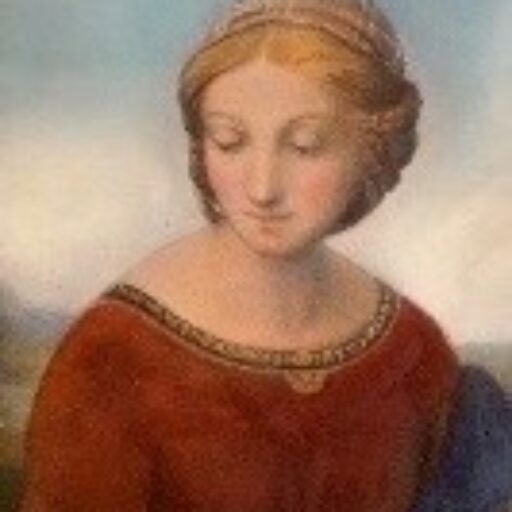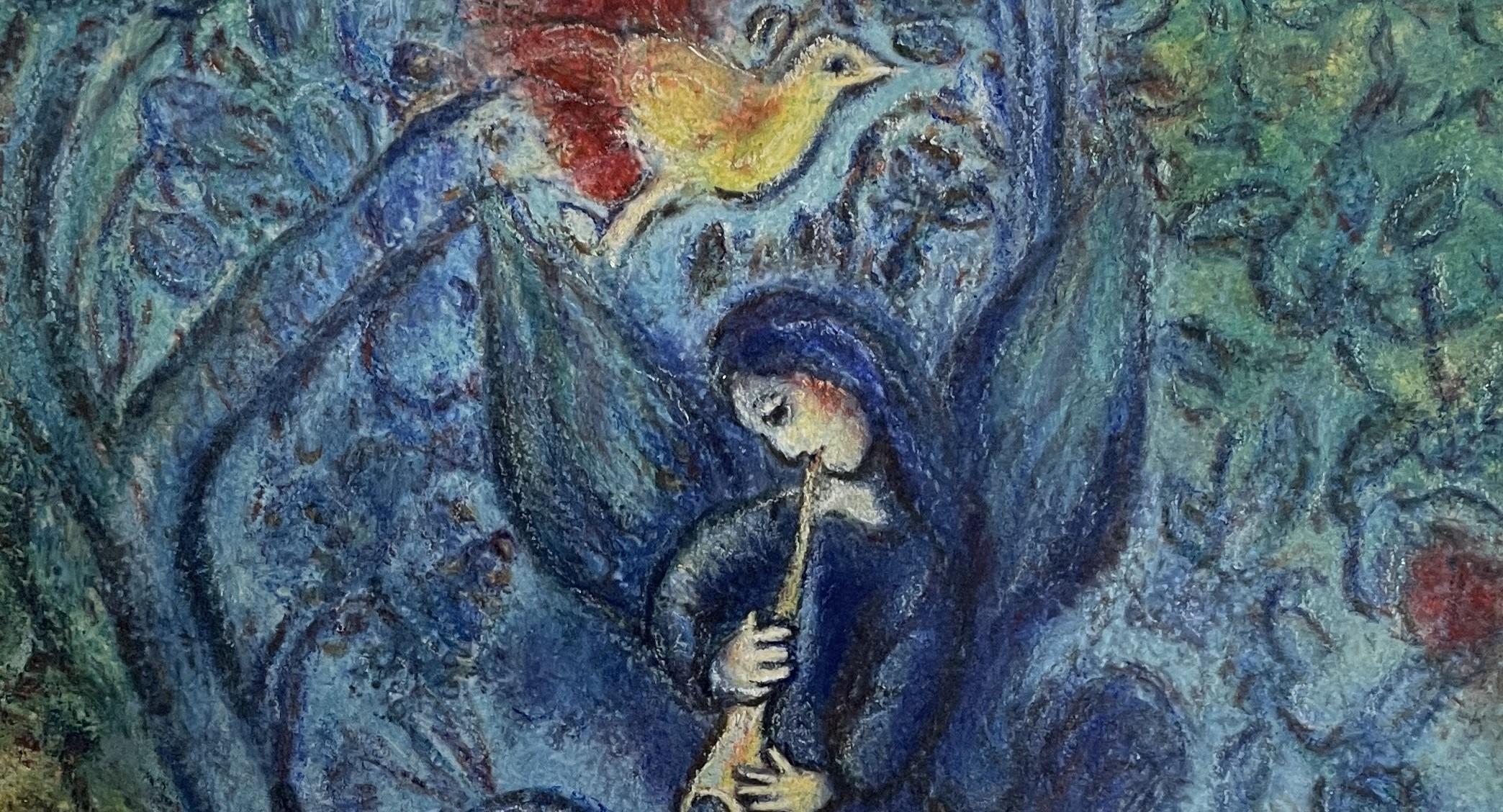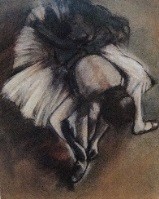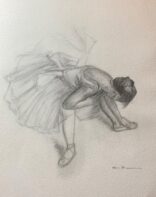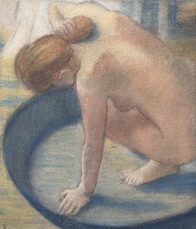日本語-Englishー台灣華語
エドガー・ドガ「紐を結ぶ踊り子」
ドガのパステル画は交錯する色線が織物のように重ねられ、何とも言えない深みのある色彩を生み出している。ドガが描くパステル画に登場する人物にはめったに個性がなく、人物は背景と一体となって色彩の中に溶け込んでいるが、確たる存在感がある。しっかりとデッサンされた人物が下地になっているに違いない。ハッチングの多様なタッチは直ぐには習得することができない。ドガのパステル画を模写する前に、私はドガのデッサンの秘密を学ばなくてはならない。
デッサンの線には描いた時のスピードが如実に現れる。それを知るためには制作現場を目撃するか、自分で描いて確認するしかない。ドガの線が惚れ惚れする出来ばえであるのと同じように、惚れ惚れとするスピードで描かれたものに相違ない。ドガはなぜ踊り子を描いたのだろうか。舞台に描かれた踊り子は、年代が下がるにつれて周囲の人物を隅に押しやり、踊り子ひとりに視線を集中していくようになる。私はまずは踊り子のデッサンを描くことにする。 写真が発明されて間もないこの時代、ドガは積極的に写真を活用しようとする。瞬間や偶然をとらえる写真が、思いがけないフォルムを提示してくれるからだ。バレエの踊り子たちの様々に変化するポーズ。たおやかな光の中に浮かびあがる踊り子の何気ない一瞬の仕草。その全てが人体の美しさとニュアンスを提示してくれる。そこには無限のバリエーションがある。
ドガは何よりも人物の微妙で独創的なフォルムを創ることに精力を注いだ画家だ。動きの決定的瞬間を描くためにバレエという題材を選んだにすぎない。ドガが同じモチーフを繰り返し描くのは、自分の頭の中にモチーフを完全に記憶し、現実の呪縛から逃れて自由にフォルムを再構成するためだ。この「靴紐を結ぶ踊り子」も様々な角度から制作されている。ドガの絵は即興的に制作されたものではなく、いつも作為的な産物なのである。何気ない仕草に見えるドガの絵は、推敲を重ねた文章のように熟慮された美の集積なのである。
ドガは言っている。「人は私のことを踊り子の画家と言うが、踊り子そのものを描こうなどとはついぞ考えたことはなかった。私の興味は女たちの動きを表現することと、美しい衣装を描くことだ」と。ドガの踊り子には感銘を受けた本質的なものだけが抽出されている。ドガはパステル画において多くの革新的技法を編み出しており、常識的なパステルの使い方を凌駕している。中でもフキサチーフ(定着剤)の処理に秘密があると私は睨んでいる。ドガは何度も何度もフキサチーフを重ね重厚感を出している。フキサチーフもドガが指定した特注のブレンド品だと言う。パステル画の教本には必ずフキサチーフをかけ過ぎないようにと注意してある。「フキサチーフをかけ過ぎるとせっかくのパステルの輝きが失われます」と書いてある。私はフキサチーフをパステルの明るさをあえて消して沈んだ感じを出すために使っている。教本には「ある程度離れて全体に満遍なく振りかけて下さい」とも書いてあるが、私は至近距離から流れる位に不規則にかけて、乾く前にブラシで擦って練り込んでいる。先入観にとらわれていると何事も先には進めない。
ドガは裕福な銀行家の長男として生まれ、家族にも応援されて画家の道を選んだが、父の死後莫大な借金を背負ってしまう。借金の容赦ない取り立てにあって、懸命に返済資金を作るために乾くまで待たなければならない油彩画に代えて、短時間で仕上がるパステル画を描くようになったと言われている。困窮した画家が辿り着いたやむを得ない方法だったとしても、ドガは次第にパステルの魅力に取り付かれて行く。色と線を自然に組み合わせることができるパステルは、ドガにとって理想的な画材だったのである。
人生何が幸いするかわからないものだ。目が悪くなるに従って、ドガの絵の輪郭線は曖昧となり、人物の仕草は益々おぼろげになる。線はより大胆となり、色彩は溢れるように豊かになる。晩年ほとんど目が見えなくなってからは、かつて描いた踊り子、馬、入浴する女の彫刻を手がけている。あらゆるフォルムを記憶に焼き付けて制作されたドガの彫刻は素晴らしい。ルノワールがドガを同時代の最も優れた彫刻家と見なしていたのも頷ける。神様は時に残酷な試練を与えるが、ドガの目が悪くなったからこそ、素晴らしい色彩と彫刻が生み出されたのかもしれない。芸術家の運命とはつくづくわからないものだ。
Ballet Dancer Adjusting her Shoes
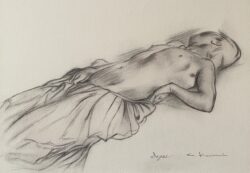
Reclining Nude
裸體女性
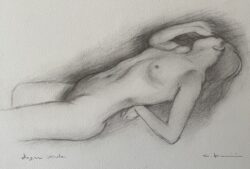
Reclining Nude
裸體女性
Degas’ pastel paintings are characterized by interlacing color lines that are layered like fabric, creating indescribably deep hues. The figures in Degas’ pastel paintings rarely have individual personalities; they blend into the background, becoming one with the colors, yet they possess a definite presence. This must be due to the well-drawn figures that underlie them. The varied touches of hatching cannot be learned overnight. Before attempting to copy Degas’ pastel works, I must learn the secrets of his drawing. The speed of his lines is clearly visible in his drawings. To understand this, one must either witness the creation process or draw it oneself. Just as Degas’ lines are captivating, they must have been drawn with a captivating speed. Why did Degas choose to draw dancers? As the years progress, dancers depicted on stage push the surrounding figures to the edges, focusing the viewer’s gaze solely on the dancer. I will start by drawing sketches of dancers.
In this era shortly after the invention of photography, Degas eagerly utilized photography. This was because photography, capturing moments and coincidences, presented unexpected forms. The various poses of ballet dancers, a fleeting gesture of a dancer illuminated in soft light, all reveal the beauty and nuances of the human body, offering infinite variations. Degas was a painter who devoted his energy to creating subtle and original forms of people more than anything else. He chose ballet as a subject simply to capture the decisive moment of movement. Degas repeated the same motifs to fully memorize them in his mind, allowing him to freely reconfigure forms, escaping the constraints of reality. His “Dancer Tying Her Shoelace” was created from various angles. Degas’ paintings were not improvised but always deliberately crafted. His seemingly casual gestures are, in fact, a culmination of beauty that has been thoroughly contemplated, like a carefully revised piece of writing. Degas said, “People call me the painter of dancing girls, but I never had the intention of painting dancers. I am interested in depicting their movements and beautiful costumes.” In Degas’ dancers, only the essential elements that made an impression are extracted.
Degas invented many innovative techniques in pastel painting, surpassing conventional uses of pastel. I suspect the secret lies in his treatment of the fixative. Degas layered fixative multiple times to achieve a sense of depth, using a specially ordered blend. Pastel painting manuals caution against over-applying fixative, warning that it can dull the sparkle of pastels. I use fixative to deliberately dull the brightness of pastels, creating a subdued effect. The manual advises to spray evenly from a distance, but I apply it irregularly from a close range and blend it with a brush before it dries. Preconceived notions must be set aside to make progress.
Degas was born the eldest son of a wealthy banker and chose the path of a painter with his family’s support. However, after his father’s death, he inherited a massive debt. Faced with relentless debt collection, he turned to pastel painting, which could be completed quickly, as opposed to oil painting, which required drying time. Though it was a method born out of necessity for a struggling artist, Degas gradually became captivated by the charm of pastels. Pastels allowed for a natural combination of color and line, making them the ideal medium for Degas. Life is unpredictable. As his eyesight deteriorated, Degas’ outline lines became more ambiguous, and the gestures of his figures increasingly indistinct. Lines became bolder, and colors richer. In his later years, almost blind, he worked on sculptures of dancers, horses, and bathing women, all created from memory. Degas’ sculptures are magnificent, and it’s understandable that Renoir considered him the greatest sculptor of their time. Perhaps it was because of his failing eyesight that Degas was able to produce such wonderful colors and sculptures. The fate of an artist is truly unpredictable.
德加《綁鞋帶的舞者》
德加的粉彩畫中,交錯的色線像織物一樣層疊,創造出難以言喻的深邃色彩。德加繪製的粉彩畫中的人物很少有個性,人物與背景融為一體,溶入色彩之中,但存在感確鑿。肯定有著紮實的素描作為基礎。多樣的劃痕技巧不是那麼容易就能掌握的。在模仿德加的粉彩畫之前,我必須學習德加的素描秘密。素描線條展現了繪畫時的速度。要知道這一點,只能親眼見到創作現場或自己畫來確認。德加的線條令人愛不釋手,無疑是以令人愛不釋手的速度繪製的。德加為何畫舞者?隨著年代的降低,舞台上的舞者將周圍的人物推向一角,視線逐漸只集中在舞者身上。我決定首先繪製舞者的素描。
在攝影發明不久的這個時代,德加積極利用攝影。因為捕捉瞬間和偶然的攝影能呈現出意想不到的形態。芭蕾舞者多變的姿態。在柔和光線中顯現的舞者的隨意瞬間姿勢。這一切都展示了人體的美麗和細膩。這裡有無限的變化。德加是一位專注於創造人物細膩獨特形態的畫家。選擇芭蕾作為題材僅僅是為了描繪動作的決定性瞬間。德加重複畫同一主題,是為了完全記住頭腦中的主題,從現實的束縛中逃脫,自由重構形態。 「綁鞋帶的舞者」也是從各個角度創作的。德加的畫作不是即興創作的,而是總是有意為之的產物。看似隨意的姿勢,其實是像反復推敲的文章一樣,經過深思熟慮的美的積累。德加說:“人們稱我為舞者的畫家,但我從未想過要畫舞者本身。我感興趣的是表達女性的動作和繪製美麗的服裝。”德加的舞者只提煉出令人印象深刻的本質。德加在粉彩畫中發明了許多創新技術,超越了常規的粉彩使用方法。特別是定着劑(Fixatif)的處理技巧,我認為其中有秘密。德加反覆使用定着劑以增加作品的厚重感。定着劑是德加指定的特製混合品。粉彩畫教程總是強調不要過度使用定着劑。“過多使用定着劑會使粉彩的光澤消失。”我使用定着劑是為了故意消除粉彩的亮度,產生沉重的感覺。教程說“應該遠距離均勻噴灑”,但我是近距離不規則噴灑,並在乾燥前用刷子摩擦混合。被先入為主的觀念束縛,就無法進步。
德加出生於富裕的銀行家家庭的長子,選擇成為畫家得到家族的支持,但父親去世後背負了巨額債務。面對無情的債務追討,為了籌集還款資金,轉而繪製短時間內可以完成的粉彩畫。即使這是困窮畫家無奈的選擇,德加也逐漸被粉彩的魅力所吸引。粉彩能自然結合顏色和線條,對德加來說是理想的繪畫材料。
人生難以預料何為幸運。隨著視力變差,德加的畫作輪廓線變得模糊,人物姿勢更加朦朧。線條變得更加大膽,色彩更加豐富。晚年幾乎失明後,他處理過去繪製的舞者、馬和入浴女性的雕塑。記憶中所有形態的德加雕塑令人驚嘆。雷諾瓦將德加視為同時代最優秀的雕塑家也是有道理的。神給予殘酷的考驗,但德加因視力變差而創作出了絕妙的色彩和雕塑,或許正是因為這樣。藝術家的命運真是難以捉摸。
